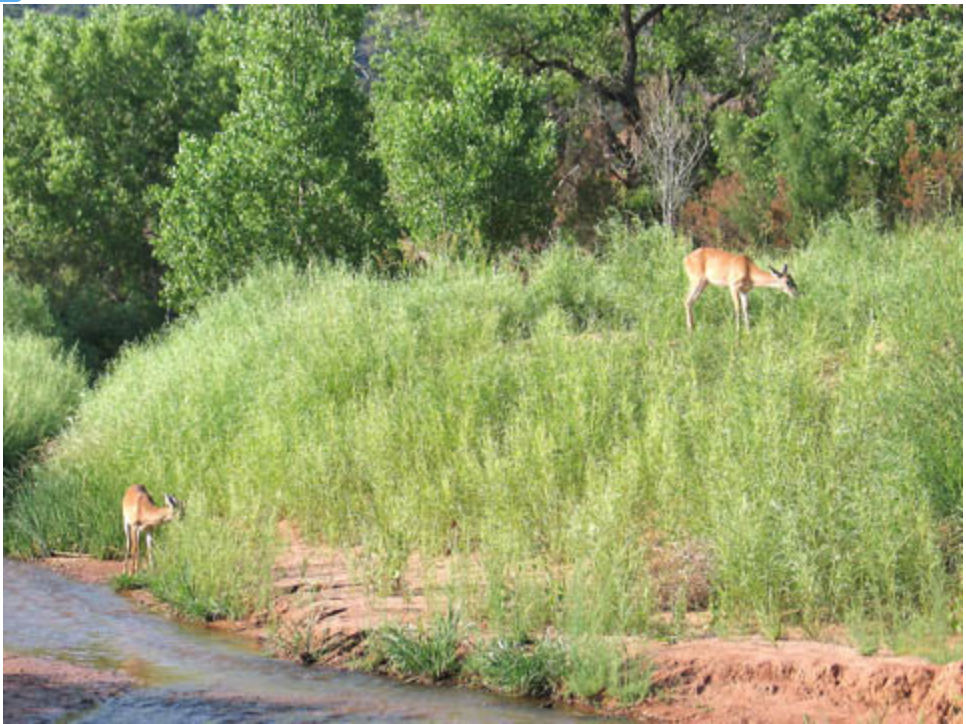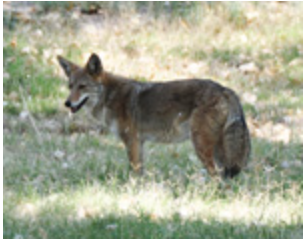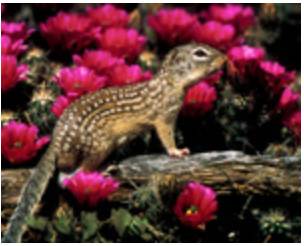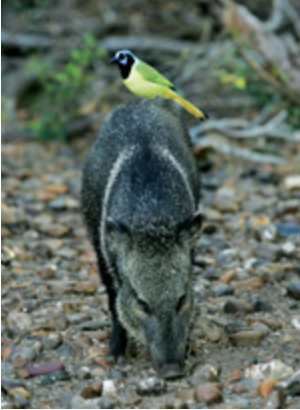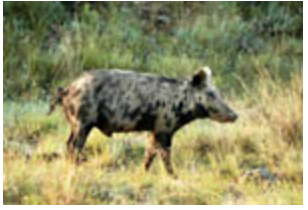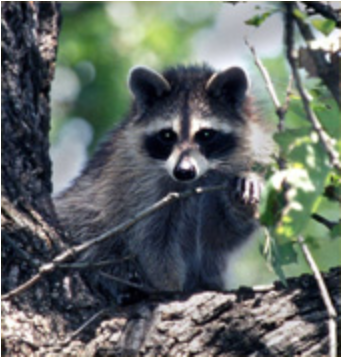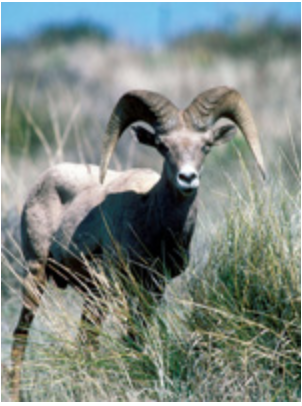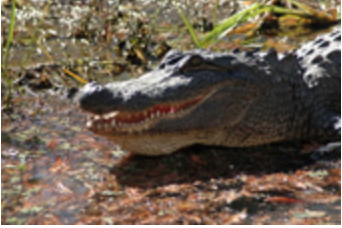Texas has many native animals and birds, as well as introduced species. More than 540 species of birds — about three fourths of all different species found in the United States — have been identified in Texas.
Some 142 species of animals, including some that today are extremely rare, are found in Texas.
A few of the leading mammals of Texas are described here. Those marked by an asterisk (*) are non-native species. Information was provided by the Nongame and Urban Program, Texas Parks and Wildlife; The Mammals of Texas Seventh Edition by David J. Schmidly and Robert D. Bradley, copyright © 1994, 2004, 2016. Courtesy of the University of Texas Press.
Mammals
Armadillo — The nine-banded armadillo (Dasypus novemcinctus) is one of Texas’ most interesting mammals. It is found in most of the state except the western Trans-Pecos. It is now common as far north and east as Oklahoma and Mississippi.
Badger — The badger (Taxidea taxus) is most common in parts of West and South Texas although they occasionally are sighted in the eastern parts of the state. It is a fierce fighter, and it is valuable in helping control the rodent population.
Bat — Thirty-two species of these winged mammals have been found in Texas, more than in any other state in the United States. Of these, 27 species are known residents, though they are seldom seen by the casual observer. The Mexican, or Brazilian, free-tailed bat (Tadarida brasiliensis) and the cave myotis (Myotis velifer) constitute most of the cave-dwelling bats of Central and West Texas. They have some economic value for their deposits of nitrogen-rich guano. Some commercial guano has been produced from James River Bat Cave, Mason County; Beaver Creek Cavern, Burnet County; and from large deposits in other caves including Devil’s Sinkhole in Edwards County, Blowout Cave in Blanco County and Bandera Bat Cave, Bandera County. The largest concentration of bats in the world is found at Bracken Cave in Comal County, thought to hold between 20 and 40 million bats. The big brown bat (Eptesicus fuscus), the red bat (Lasiurus borealis) and the evening bat (Nycticeius humeralis) are found in East and Southeast Texas. The evening and big brown bats are forest and woodland dwelling mammals.
Most of the rarer species of Texas bats have been found along the Rio Grande and in the Trans-Pecos. Bats can be observed at dusk near a water source, and many species may also be found foraging on insects attracted to street lights. Everywhere bats occur, they are the main predators of night-flying insects, including mosquitoes and many crop pests. On the Web: www.batcon.org/
Bear — The black bear (Ursus americanus), formerly common throughout most of the state, is now surviving in remnant populations in portions of the Trans-Pecos. Recently, some have been moving into East Texas from neighboring states. (Click, for additional discussion of habitat.)
Beaver — The American beaver (Castor canadensis) is found over most of the state except for the Llano Estacado and parts of the Trans-Pecos.
Bighorn — (See Sheep.)
Bison — The largest of native terrestrial wild mammals of North America, the American bison (Bos bison), commonly called buffalo, was formerly found in the western two-thirds of the state. Today it is extirpated or confined on ranches. Deliberate slaughter of this majestic animal for hides and to eliminate the Plains Indians’ main food source reached a peak about 1877-78, and the bison was almost eradicated by 1885. Estimates of the number of buffalo killed vary, but as many as 200,000 hides were sold in Fort Worth at a single two-day sale. Except for the interest of the late Col. Charles Goodnight and a few other foresighted men, the bison might be extinct.
Cat — The jaguar (Felis onca) is probably now extinct in Texas and, along with the ocelot, jaguarundi and margay, is listed as rare and endangered by both federal and state wildlife agencies. The mountain lion (Felis concolor), also known as cougar and puma, was once found statewide. It is now found in the mountainous areas of the Trans-Pecos and the brushlands of South Texas and portions of the Hill Country. The ocelot (Felis pardalis), also known as the leopard cat, is found usually along the border. The red-and-gray cat, or jaguarundi (Felis yagouaroundi Geoffroy) is found, rarely, in extreme South Texas. The margay (Felis wiedii) was reported in the 1850s near Eagle Pass. The bobcat (Lynx rufus) is found over the state in large numbers.
Chipmunk — The gray-footed chipmunk (Tamias canipes) is found at high altitudes in the Guadalupe and Sierra Diablo ranges of the Trans-Pecos (see also Ground Squirrel, with which it is often confused in public reference).
Coati — The white-nosed coati (Nasua narica), a relative of the raccoon, is occasionally found in southern Texas from Brownsville to the Big Bend. It inhabits woodland areas and feeds both on the ground and in trees. The coati, which is on the list of threatened species, is also found occasionally in Big Bend National Park.
Coyote — The coyote (Canis latrans), great in number, is the most destructive Texas predator of livestock. On the other hand, it is probably the most valuable predator in the balance of nature. It is a protection to crops and range lands by its control of rodents and rabbits. It is found throughout the state, but is most numerous in the brush country of Southwest Texas. It is the second-most important fur-bearing animal in the state.
Deer — The white-tailed deer (Odocoileus virginianus), found throughout the state in brushy or wooded areas, is the most important Texas game animal. Its numbers in Texas are estimated at more than 3 million. The mule deer(Odocoileus heminous) is found principally in the Trans-Pecos and Panhandle areas. It has increased in number in recent years. The little Del Carmen deer (white-tailed subspecies) is found in limited numbers in the high valleys of the Chisos Mountains in the Big Bend. The only native elk in Texas (Cervus merriami), found in the southern Guadalupe Mountains, became extinct about the turn of the 20th century. The wapiti or elk (Cervus elaphus), was introduced into the same area about 1928. There are currently several herds totalling several hundred individuals.
A number of exotic deer species have been introduced, mostly for hunting purposes. The axis deer* (Cervus axix)is the most numerous of the exotics. Native to India, it is found mostly in Central and South Texas, both free-ranging and confined on ranches. Blackbuck* (Antilope cervicapra), also native to India, is the second-most numerous exotic deer in the state and is found on ranches in 86 counties. Fallow deer* (Cervus dama), native to the Mediterranean, has been introduced to 93 counties, while the nilgai* (Boselaphus tragocamelus), native of India and Pakistan, is found mostly on ranches in Kenedy and Willacy counties. The sika deer* (Cervus nippon), native of southern Siberia, Japan and China, has been introduced in 77 counties in Central and South Texas.
Dolphin — The Atlantic spotted dolphin (Stenella frontalis) is rather small, long-snouted, and spotted; it is purplish gray, appearing blackish at a distance, usually with numerous small white or gray spots on its sides and back. In the Gulf of Mexico, this dolphin is second in abundance only to the bottlenose dolphin. The bottlenose (Tursiops truncatus)is stout and short-beaked with sloping forehead, projecting lower jaw, and high dorsal fin. Other species, such as the Clymene, the Common dolphin, the Pantropical Spotted, Risso's, Rough-toothed, Spinner, and Striped are unusual and known in Texas only through strandings along Gulf beaches.
Ferret — The black-footed ferret (Mustela nigripes) was formerly found widely ranging through the West Texas country of the prairie dog on which it preyed. It is now considered extinct in Texas. It is of the same genus as the weasel and the mink.
Fox — The common gray fox (Urocyon cinereoargenteus) is found throughout most of the state, primarily in the woods of East Texas, in broken parts of the Edwards Plateau, and in the rough country at the foot of the High Plains. The kit or Swift fox (Vulpes velox) is found in the western one-third of the state. A second species of kit fox(Vulpes macrotis) is found in the Trans-Pecos and is fairly numerous in some localities. The red fox* (Vulpes vulpes), which ranges across Central Texas, was introduced for sport.
Gopher — Nine species of pocket gopher occur in Texas. The Botta’s pocket gopher (Thomomys bottae) is found from the Trans-Pecos eastward across the Edwards Plateau. The plains pocket gopher (Geomys bursarius) is found from Midland and Tom Green counties east and north to McLennan, Dallas and Grayson counties. The desert pocket gopher (Geomys arenarius) is found only in the Trans-Pecos, while the yellow-faced pocket gopher(Cratogeomys castanops) is found in the western one-third of the state, with occasional sightings along the Rio Grande in Maverick and Cameron counties. The Texas pocket gopher (Geomys personatus) is found in South Texas from San Patricio County to Val Verde County. Attwater’s pocket gopher (Geomys attwateri) and Baird’s pocket gopher (Geomys breviceps) are both found generally in South Central and Coastal Texas from the Brazos River to the San Antonio River and south to Matagorda and San Patricio counties. Jones’ pocket gopher (Geomys knoxjonesi) is found only in far West Texas, while the Llano pocket gopher (Geomys texensis) is found only in two isolated areas of the Hill Country.
Ground Squirrel — Five or more species of ground squirrel live in Texas, mostly in the western part of the state. The rock squirrel (Spermophilus variegatus) is found throughout the Edwards Plateau and Trans-Pecos. The Mexican ground squirrel(Spermophilus mexicanus) is found in southern and western Texas. The spotted ground squirrel (Spermophilus spilosoma) is found generally in the western half of the state.
The thirteen-lined ground squirrel (Spermophilus tridecemlineatus) is found in a narrow strip from Dallas and Tarrant counties to the Gulf. The Texas antelope squirrel (Ammospermophilus interpres) is found along the Rio Grande from El Paso to Val Verde County.

